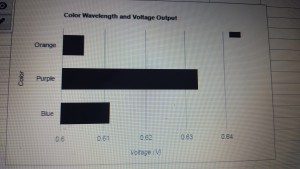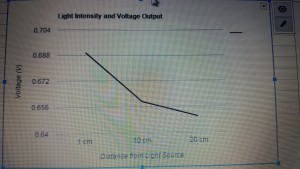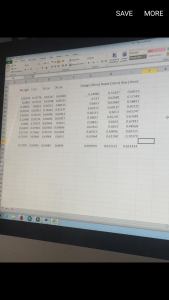Explanation
The solar energy experiment allowed us to understand the implementation of photovoltaic cells. “Photovoltaic is the name of a method of converting solar energy into direct current electricity using semiconducting materials that exhibit the photovoltaic effect, a phenomenon commonly studied in physics, photochemistry and electrochemistry.”
Solar energy has become extremely popular according to renewableenergyworld.com, “The solar panel is becoming an increasingly popular form of alternative energy around the world, using photovoltaic and silicon solar cells to convert radiation into power. Solar power has had a long history of failed starts and limited distribution. As an alternative to the burning of fossil fuels, solar panels rank alongside wind and hydropower as essential energy options for the future of the planet, and offer the additional benefit of being easier to integrate into the home.”
The experiment in class allowed us to see how voltage has an effect on distance and by using colored filters (red, blue and green) we were able to see how this would change the voltage. Our professor discussed about the source of light where the closer the panel is to the light then a better result of voltage would be presented. We once again used the Lego NXT robot, the colored filters as mentioned before, the Labview program, Excel, a ruler and a solar cell.
By using the colored filters we were able to measure which one allowed the highest amount of voltage. Each color had a different result. The other stage of the experiment consisted of us holding the flashlight at different distances from the solar cell using several attempts to get a variety of results. Our results displayed that when the voltage decreased the distance between the flashlight and the solar cell was further and increased as the flashlight was closer to flashlight.
Results
Our results had a slight issue due to the LabView reading at 1cm. Meaning our results are not as accurate as they should be.
Our first test was voltage with no source of light. The result produced was 0.22505. We next used the flashlight and the solar sensor, we used the measurements of 1cm, 10cm and 20cm. Like mentioned before the voltage was decreasing the closer it was from the light source. Our results were 0.68954 V (1 cm), 0.65889 V (10 cm) and 0.6499 V (20 cm)
The other part of the experiment was running the LabView program for another three times. We now used the filters. They all produced a similar result with Orange (0.60499 V), Purple (0.63323 V) and Blue (0.61141 V).
Below is our graph.



http://www.renewableenergyworld.com/ugc/blogs/2012/09/the-growing-popularity-of-solar-panels.html
You have a real ability for writing unique content. I like how you think and the way you represent your views in this article. I agree with your way of thinking. Thank you for sharing. Healthy Marriage
Hi there, I found your blog via Google while searching for such kinda informative post and your post looks very interesting for me. Guest Posting
Looking for free bingo games?Join the ultimate online bingo experience with Bingo Cash ! Test your skills to compete against players in real time. Join now and bingo for cash!
Solar energy, with the use of solar panels and photovoltaic cells, has indeed gained popularity as a sustainable and clean alternative energy infinite craft source. The mention of its history and the comparison with other renewable energy options like wind and hydropower highlights its significance in the quest for environmentally friendly energy solutions.
Your willingness to consider multiple perspectives helps foster understanding. Solar
Cheers for this kind of data I was checking all Google to locate it สมัคร หวยบี
I am grateful for the clarity and insight your article has provided. Nhà cái sagaming